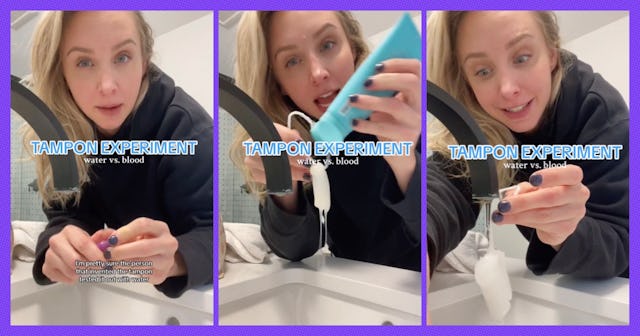TikTok Mom Calls Out Tampon Companies For Testing Their Products With Saline Solution
“Somebody fix this!”

Have you ever wondered why even when you’re wearing a super jumbo tampon, you somehow still leak while on your period? Yeah, it’s totally annoying. Turns out, there’s probably a reason for why this happens, and it has absolutely nothing to do with you or your heavy flow.
Content creator and TikTok mom Renee Reina went viral after she called out tampon companies for their total lack of thought or research when it comes to the absorbency of tampons. And she’s right, like, every single tampon or pad commercial shows blue liquid being poured onto the product. Who has period blood the consistency of water? Answer: no one.
Reina, who hosts a podcast called The Mom Room, declared that whoever invented the tampon and conducted research on their effectiveness has to be a man.
“I’m pretty sure the person that invented the tampon tested it out with water, and they were like, ‘Oh my god, it’s perfect! Oh my god!’” she jokes, impersonating tampon inventors while running her sink faucet on a tampon. The tampon expands instantly, absorbing the water.
“It was a man by the way. Now little did they know that the consistency of blood, especially period blood, is not water.”
She then takes a face wash bottle, more the consistency of thick period blood, and pours it on the tampon. Unsurprisingly, nothing happens to the tampon and the shampoo drips right on down.
“And, so you see that’s what’s happening inside. Just leaking right on by. All right, can we fix this? Somebody fix this,” she concludes.
Turns out, she’s right. Tampons were invented and tested by men. The tampon was invented by a man named Earl Haas in 1931. Later, Gertrude Tendrich produced the first commercial tampon brand, Tampax, using Haas’ patented design.
While the tampon was invented over 90 years ago, it wasn’t until this year that menstrual products were tested with anything other than water.
How hard is it to design things for what they’re actually used for? Apparently very difficult when it comes to things almost exclusively used by women.
According to a recent paper published in August 2023 in BMJ Sexual & Reproductive Health, many menstrual products have a much lower or higher liquid capacity than advertised when real blood was used instead of a saline solution — a mixture of water, salt, and bicarbonate that is more commonly employed in the product development process.
It’s the first known study to test the absorbency of period products with actual period blood, the researchers say.
Anyone with an elementary school level education knows that blood and saline solution have very different thicknesses and viscosities — and that means that they are absorbed differently.
“The saying ‘blood is thicker than water’ is technically true,” study co-author Samuelson Bannow told Scientific American. “We really felt that [the absorbency metric] needed to be updated.”
A group of male scientists thinking that saline solution is a great alternative to period blood are literally putting women’s lives at risk because this study suggests that doctors may be under-diagnosing heavy menstrual bleeding, which can be a sign of certain medical conditions.
It’s important to catch this type of excessive bleeding, Bannow added, because this can be a sign of more serious conditions, including bleeding disorders, certain types of cancer and fibroids — smooth muscle tumors in the lining of the uterus. It can also lead to anemia.
In the defense of tampon research labs, blood is hard to come by. Period product manufacturers can’t get their hands on the substance.
“Frequent blood shortages in hospitals make it difficult to justify using donations for anything other than transfusions. The fluid is also considered a potential biohazard. Researchers who handle blood in the lab must undergo training and take special precautions to work with it safely,” Scientific American stated.
Plus, blood (and artificial blood) is expensive.
A 10-milliliter vial of research-quality human blood costs around $100. Meanwhile 200 milliliters of high-quality synthetic blood —a lab-made mixture of amino acids and hemoglobin — can run upward of $150. In contrast, labs can buy a full liter of saline solution for $45.
And despite this one research journal paper calling out this gross negligence when it comes to menstrual product research, saline solutions are still predominantly employed to test menstrual products today.
Some TikTok users ion Reina’s comment section recommended people with periods switch over to other alternatives like menstrual cups or period underwear.
“Try a menstrual cup, I will never get back to tampons after them!” one user wrote.
Another wrote, “Since switching to a cup I’ve had no cramps, and my period only lasts 2-3 days.”
In a follow-up video, Reina shared some eyeroll-worthy comments she received on her viral video from men.
“If you’re a woman out there struggling with menstrual issues, just ask a man, because they know,” she says sarcastically before reading some of the ridiculous comments.
“If your flow is that thick, you need to consume water,” one comment said, to which Reina replied, “Um, we’re talking periods, sir? Not cutting your finger.”
“No, they tested it with healthy women. Time to visit your doctor. There is something wrong with your brain,” another comment read.
Is there anything more “mansplainy” than a man explaining how periods work to a woman? Cue “The Man” by Taylor Swift!